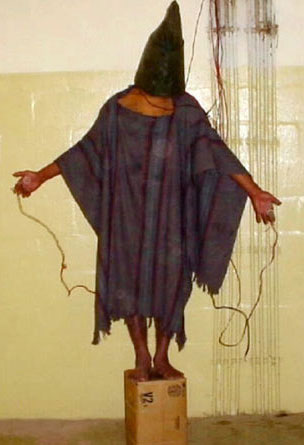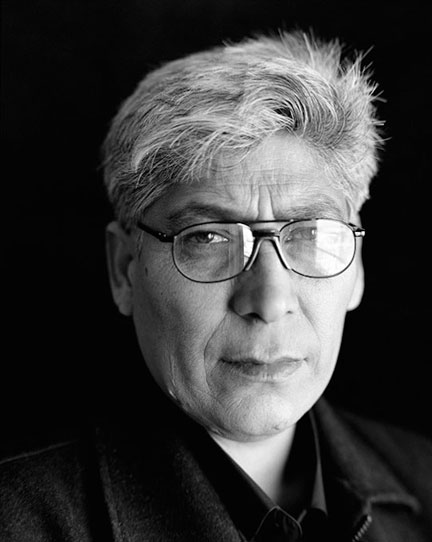Chris Bartlett: Iraqi Detainees
2014 marks the 10-year anniversary of the release of the infamous Abu Ghraib prison photographs, an event remembered by Iraqi Detainees, an unusual exhibition in Brooklyn, New York. The exhibit of photos by Chris Bartlett is evidence enough that the wounds from the U.S. war against Iraq that began on March 19, 2003 have not yet healed. But as I write this article on Sept. 23, 2014, President Obama’s order to conduct airstrikes against the self-proclaimed “Islamic State” in Syria is being carried out to deadly effect. On the first day of the new war, the U.S. launched some 47 cruise missiles from Navy warships and used drones, B-1 bombers, F-15 and F-16 fighter jets, as well as F-22 Raptor jet fighters to strike at ISIS extremists in northern Syria.
Obama the “Constitutional scholar” ordered the airstrikes despite not having Congressional authorization to back-up his actions, nor did the Nobel Peace Laureate seek a UN Security Council resolution to justify the new war. In touting the participation of the utterly corrupt Arab potentates of Bahrain, United Arab Emirates, Saudi Arabia, Jordan, and Qatar in supporting his bombing raids, Obama sought to give the appearance of a broad and “historic coalition.” In spite of this, U.S. military officials have stated that the U.S. has launched the vast majority of airstrikes. The president has placed the U.S. in the middle of a war that will only grow larger.

Now dragged into the Syrian quagmire, which will unquestionably be inherited by Obama’s successor, Americans should reflect on what was initially referred to as, “Operation Iraqi Liberation” (OIL), the 2003 U.S. invasion of Iraq and the eight-year long occupation that followed. One of that war’s many scandals was centered around how the U.S. Army and the CIA committed human rights abuses against the prisoners held at Baghdad’s Abu Ghraib prison.
From 2003 to 2004, Iraqis were sexually abused and raped, tortured, beaten, humiliated, and killed in the Abu Ghraib prison by their American guards, some of whom documented their abuses with hand-held cameras. When a number of those photos became public in 2004, the notion of the U.S. being the international defender of human rights went up in smoke; the photograph of a hooded prisoner standing on a narrow box, his arms outstretched and connected to electric wires, can still be considered the iconic photo from that phase of the Iraq war.
The international arts community responded to the barbarous acts committed by Americans at Abu Ghraib prison, from the 2004-2005 paintings by famed Columbian artist Fernando Botero, to the 2004 Stop Bush artwork by the American minimalist sculptor Richard Serra. There were of course legions of artists that created works in opposition to the madness that was the Iraq war, but one has to ask the arts community, “now that the madness continues with Obama… what happened to all of your fury and indignation?”
Chris Bartlett’s Iraqi Detainees project is a reconsideration of those horrific Abu Ghraib prisoner photos. In 2006 Bartlett accompanied attorney Susan Burke on trips to Amman, Jordan and Istanbul, Turkey, to interview former Iraqi detainees held at Abu Ghraib. The interviews were conducted in preparing a lawsuit against the U.S. Department of Defense regarding the detention and torture of prisoners. During that process Bartlett asked former prisoners, men and women, for their consent to be photographed; those photos served as the foundation for the Iraqi Detainees project.

Bartlett prefers to use natural lighting to capture his subjects, and this is the method he used in photographing the former Iraqi prisoners. Each individual was photographed against a black background, isolating extraneous details and compelling the viewer to face the subject head-on.
While Bartlett’s compassionate photos restore “humanity through beautiful portraiture,” they also make a much larger point about professional photography in general – how it is used to advance either the noble or the intolerable.
Bartlett told the BBC that in the case of the American guards at Abu Ghraib, “The camera was an instrument of abuse. The soldiers, the perpetrators of abuse, took the camera and used it to humiliate their subjects (….) I was using one of the instruments of their torture to bring some of their humanity back to them.”
The contrast noted by Bartlett, that one can use a camera to degrade or elevate, was partly seen in the microcosm of a torture chamber. However, stepping back from the dungeon to view the role of photography in the wider society, the same dynamic is found. A photographer can work to distract and obfuscate, uplift and enlighten, to cognize the complexities of life or to bury wisdom in the junk pile of commercialism. The same of course applies to artists in the fine art world. With Iraqi Detainees, Bartlett took a giant step outside the milieu of commercial product and fashion photography to produce some deeply affecting and humanistic photographs.
In an interview with The Intercept, Bartlett said that after having been robbed of their rights and dignity in the confines of the notorious prison, he “wanted to put these people back in front of the camera and use photography as a humanizing force.” All of the individuals photographed by Bartlett were detained by the U.S. military at Abu Ghraib, and though none were ever charged with any crime, each suffered horrible abuse and torture before being released.
Consider Bartlett’s portrait photograph of Ali Shalal Qaissi, which illustrates this article. It is difficult to imagine a man of such demeanor – beaten, hooded and electrocuted by his U.S. guards. According to Bartlett, Qaissi was “forced to lie on the ground, loudspeakers blasting music into his ears.” His guards “beat him regularly, and, on three occasions, subjected him to electric shock.” Mind you, Mr. Qaissi was never charged with committing any crime, he was simply picked off the street on Oct. 3, 2003, detained at Abu Ghraib, tortured, and finally released on Oct. 13, 2004. After his release, Qaissi founded the Association of Victims of American Occupation Prisons in Baghdad.
It should be remembered that in May of 2009, Obama blocked the court-ordered release of around 2,000 damning pictures taken by U.S. guards at Abu Ghraib, despite Obama’s earlier “promise” to have them released. The photos showed what the president himself described as “torture, abuse, rape and every indecency.” No commanding officer, Defense Department official, or high ranking figure in the Bush administration was ever charged, let alone faced trial, for what happened at Abu Ghraib. It should also be noted that during Obama’s 2008 run for president, he promised to review evidence of the abuse that occurred at Abu Ghraib and at a secret CIA prison in Afghanistan, because, as Senator Obama put it, “Nobody is above the law.” After winning the election, President Obama blocked investigations into the torture and murder of Afghan and Iraqi prisoners in U.S. custody, saying in April 2009 that “this is a time for reflection, not retribution.”
Iraqi Detainees opened on Sept. 9, 2014 at Photoville in the Brooklyn Bridge Park of Brooklyn, New York. Fittingly, Photoville exhibits a wide range of photography in an outdoor modular venue ingeniously constructed from giant metal shipping containers. It is the greatest of ironies that the same type of containers played a very different role during the early days of the 2003 war in Iraq. It is difficult not to think of the following when looking at the exhibit of Bartlett’s photos: interrogations of Iraqi prisoners conducted by U.S. military-intelligence soldiers and civilian contractors at Abu Ghraib were held in metal shipping containers.
In 2001, during the U.S. invasion of Afghanistan, thousands of Taliban prisoners were locked into metal shipping containers by Afghan warlords allied to the United States. Given no food or water, the prisoners suffocated to death in the extreme heat, or died when their captors riddled the containers with bullets. A declassified U.S. State Department intelligence report estimated that around 1,500 Taliban prisoners of war were killed in this manner.
Iraqi Detainees will run at Photoville until Sept. 28, 2014. Photoville is located in Brooklyn Bridge Park – click here for directions. For more information on the detainee photos, visit: www.detaineeproject.org. For more on the work of Mr. Bartlett, visit www.chrisbartlettstudio.com.

